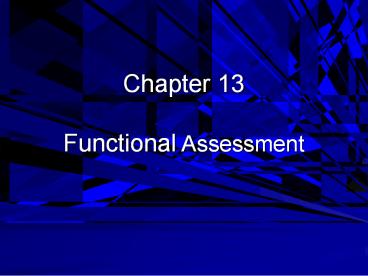Functional Assessment - PowerPoint PPT Presentation
Title:
Functional Assessment
Description:
( Did problem behaviors decrease/desirable behaviors increase? ... A 6 year old autisitc child's hand waving. antecedents: not engaged in a task or interaction ... – PowerPoint PPT presentation
Number of Views:247
Avg rating:3.0/5.0
Title: Functional Assessment
1
Chapter 13
- Functional Assessment
2
Treatment Process - Decreasing Problem Behaviors
- 1. Identify and define problem behavior(s)
- 2. Initiate data collection
- 3. Complete functional assessment
- - Hypotheses about antecedents and consequences
- 4. Treatment development and implementation
- 5. Evaluation
3
5. Evaluation (cont)
- Was treatment effective? (Did problem behaviors
decrease/desirable behaviors increase?) - YES - Promote maintenance generalization
- NO - Was treatment done correctly?
- YES Repeat step 3 (Functional Assessment)
- NO Do it right
4
Behavioral Model
- Behavior is influenced by antecedents and
consequences A ? B ? C - - Consequences reinforcement, extinction,
punishment - - Antecedents SD, S-delta, EO
- Behavior is influenced by competing behaviors
(concurrent operants) - - Desirable behaviors vs undesirable behaviors
5
Functional Assessment What to Assess?
- Antecedents SDs S?s EOs
- - When, where, with whom, what circumstances or
situations does the behavior occur? - - Social and environmental antecedents
- Behavior Problem behavior
- Alternative behavior
- Response effort
- Consequences Positive or negative reinforcement
- - What does the person get or get out of
following the behavior? - - Social and environmental consequences
- Schedule of reinforcement
- Magnitude of reinforcement
- Immediacy of reinforcement
6
Categories of Reinforcement (Functions of
Problem Behaviors)
- Social positive reinforcement
- attention, praise, reactions, activities, things
- (mediated by others)
- Social negative reinforcement
- escape from tasks, activities, interactions
- (mediated by others)
- Automatic positive reinforcement
- sensory stimulation
- (not mediated by others)
- Automatic negative reinforcement
- relief from pain, anxiety, or other aversive
stimulation - (not mediated by others)
7
Examples
- A 4 year olds tantrums
- antecedents requests during preferred activities
- consequences escape from requested activity
- A 4 year olds tantrums
- antecedents told he cant have something
- consequences gets the thing he asked for
- 10 year olds hair pulling
- antecedents alone, negative thoughts and
emotions - consequences relief from negative
thoughts/emotions - A 6 year old autisitc childs hand waving
- antecedents not engaged in a task or interaction
- consequences visual stimulation
8
Examples
- 17 year olds hair pulling/manipulation
- Antecedents Alone, watching TV
- Consequences tactile stimulation
- 17 year olds hair pulling
- Antecedents watching TV, mom busy in the room
- Consequences attention
- 8 year olds wrist biting
- Antecedents during tooth brushing, sore gums
- Consequences escape fro tooth brushing
- 18 year olds binge eating
- Antecedents aloe, sad, negative thinking
- Consequences relief from negative
feeling/thoughts
9
Functional Assessment Methods
- 1. Indirect (informant) assessment
- - behavioral interview
- - questionnaires and rating scales
- 2. Direct observation assessment
- - scatter plot recording
- - descriptive A-B-C recording
- - checklist recording of A-B-Cs
- - interval recording of A-B-Cs
- 3. Experimental manipulations
- (functional analysis)
- - manipulate antecedents and/or consequences
- - evaluate a number of possible functions or
- - test hypothesis from descriptive assessments
10
Conducting a Functional Assessment
- Begin with an interview or other indirect
assessment method - Develop a hypothesis about the antecedents and
consequences (the function of the behavior) - Conduct direct observation assessments
- Confirm or modify original hypothesis based on
direct observation assessment - If assessments are consistent, develop and
implement treatment that addresses the function
of the behavior - If indirect and direct assessments are not
consistent, conduct further functional
assessments - Conduct functional analysis to confirm hypothesis
or resolve inconsistency between indirect and
direct assessment































